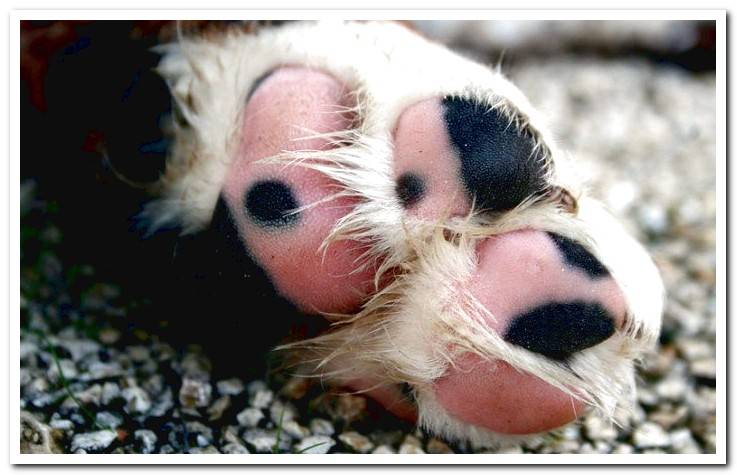
Pododermatitis is a pathology that can affect the feet and hands of dogs. Being a part of the body in continuous contact with the ground, it is especially vulnerable.
Therefore we must monitor this area regularly. If we find any alteration, such as pododermatitis, we will have to seek veterinary assistance. Delaying it could aggravate the symptoms in our dog, damaging its health.
- You may also like: Symptoms of acral lick dermatitis
Index of contents
- 1 What is pododermatitis?
- 2 What causes pododermatitis?
- 3 Which breeds suffer from pododermatitis most frequently?
- 4 Symptoms of pododermatitis in dogs
- 5 How do I know if my dog has pododermatitis?
- 6 How is pododermatitis diagnosed?
- 7 What is the treatment for pododermatitis?
What is pododermatitis?
Pododermatitis is defined as the inflammation of the feet and hands, specifically the spaces between the toes, which are called interdigital. Behind this inflammation we can find very different causes.

What causes pododermatitis?
The most common causes of pododermatitis in dogs are trauma, that is, blows to the feet or hands, or the presence of foreign bodies such as stones, chips, crystals, etc. They can cause injuries of greater or lesser severity.
But there are other causes like the following:
- Contact dermatitis, which is the inflammation that occurs when the skin reacts to the presence of various irritants such as cleaning products, plants, etc.
- Allergies, in which the immune system overreacts to substances that, a priori, do not pose a real danger to health.
- Parasites such as mites scabies.
- Mushrooms.
- Endocrine-related diseases such as hypothyroidism.
- Autoimmune diseases in which the immune system attacks your own body.
- Appearance of cysts in the interdigital area.
- Dogs with psychological problems They can also lick their feet compulsively to the point of causing pododermatitis.
Which breeds suffer from pododermatitis most frequently?
Any dog can be affected but, as it is usually caused by blows or foreign bodies, they will be more likely to suffer from pododermatitis those with a more active life that they jump, run or transit stony, wooded areas or, in general, any more or less steep terrain.
Thus, it will be easier for us to observe pododermatitis in dogs that are dedicated to hunting, racing or guiding livestock, simply because they are more exposed to injuries to their feet and hands due to their living conditions.

Symptoms of pododermatitis in dogs
Next we will see what are the most frequent signs that can indicate that the dog is suffering from pododermatitis. We can see them on one or more legs and they are as follows:
- Redness of the interdigital zone.
- Inflammation of the feet that can affect the legs.
- Nodules.
- Wounds or blisters.
- Secretions that may contain blood.
- Lameness due to pain.
- Darkening of the hair in the area as a result of frequent licking.
- This excessive licking ends up causing hair loss.
- When the area becomes inflamed, complications may arise that aggravate the condition, such as bacterial infections.
How do I know if my dog has pododermatitis?
Any of the symptoms that we have described is reason for veterinary consultation. It is this professional who will be able to confirm or rule out the diagnosis. As there are so many causes that may be behind pododermatitis, it is necessary to make the right diagnosis.
In other words, Pododermatitis is easy to identify because it is nothing but inflammation of the interdigital zone. The complicated thing is to determine the cause that has caused it. The number of legs affected can give us a clue. Thus, if the pododermatitis is only in one it is easier than due to a foreign body or a blow.
On the other hand, when we find more than one leg in poor condition, the most likely diagnosis will be some systemic disease such as an allergy, scabies or autoimmune problems.

How is pododermatitis diagnosed?
To find out what caused pododermatitis, the vet can examine hair and skin for parasites. A blood test can reveal the existence of systemic diseases. It is also possible to take a sample and request a biopsy. Elimination tests and diets are available to detect potential allergens.
What is the treatment for pododermatitis?
Logically, the treatment will depend on the triggering cause of the pododermatitis, hence the importance of confirming the diagnosis.
We highlight the following guidelines for recovery:
- If there is a bacterial infection, antibiotics are essential. On the other hand, if what they find is mushrooms, the treatment will be antifungal. The presence of parasites is combated with the appropriate dewormer.
- Disinfectants like chlorhexidine may be prescribed to keep the area as clean as possible.
- Foreign bodies must be removed.
- Allergies are not cured but it is possible to treat them to improve the dog’s quality of life and control the symptoms.
- If we have to disinfect or apply topical treatments, it may be a good idea to carefully trim the hair in the area.
- In some cases, an Elizabethan collar will be needed to prevent the dog from continuing to lick the affected area, since licking worsens the condition and complicates recovery.
